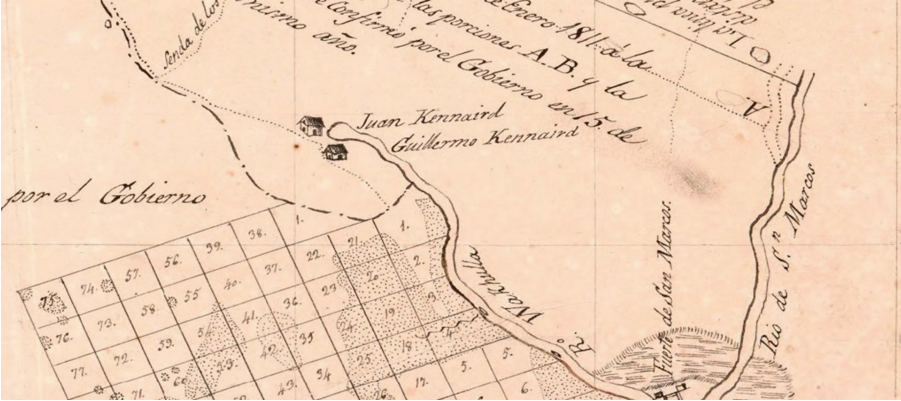
Wakulla Springs Historic Time Line
36 TO 20 MILLION YEARS AGO
The limestone bedrock in the Wakulla Springs area, formed at the bottom of a warm, shallow ocean and is similar to those bedrocks in the Florida Keys, the Bahamas, and other parts of the Caribbean. The organic sources of limestone carbonates were mostly animals which used carbonate minerals to build the hard skeletal parts of their bodies. Over millions of years, the hard skeletal body parts settled to the ocean floor forming the limestone.
THE PAST FEW MILLION YEARS
For extended periods of time, the sea level was lower than the bedrock. This exposed the limestone to fresh water erosion that formed the caves, sinkholes and springs that we see today.
120 THOUSAND YEARS AGO
The sea level was higher (with the shore reaching into Middle Georgia) and Wakulla Springs was at the bottom of a bay in the Gulf of Mexico. This is similar to the Spring Creek Springs of today, located a few miles south of Wakulla, just off shore in the Gulf of Mexico.
14,000 – 10,000 YEARS AGO
When sea levels were much lower than today and the shoreline south of here extended 400 miles into the Gulf of Mexico, the ancestors of the Apalache lived along the streams and sinkholes. Wakulla Springs was a karst window similar to the current Cherokee Sink. Mastodons and other large animals were hunted here where the climate was milder and very dry.
10,000 B.C. – 3,000 YEARS AGO
At the end of the last ice age the earth’s temperature and its oceans rose to their current levels and the Wakulla karst window once again became a spring with a river flowing to the Gulf of Mexico. The population we call Apalache farmed the fertile areas and lived between the Aucilla and Ochlockonee rivers. A small village named Aute was located on the Wakulla River a short distance from the spring.
FIRST SPANISH PERIOD (1528 – 1763)
A few decades after Columbus landed in the Caribbean in 1492 about 50,000 Apalache lived in Florida’s Big Bend area. When the first Spanish conquistadors arrive in the 16th century, they find large Apalache settlements in the Tallahassee area (Lake Jackson Mounds State Park).
-1528
Panfilo de Narvaez and his Spanish explorers arrive on horses and on foot seeking gold. The expedition’s treasurer, Cabeza de Vacca, survives to write about the voyage that ended tragically for Narvaez. The first Europeans to explore the Wakulla Springs area arrive at an Apalache hamlet known as Aute in 1528. It would be several years before other Spanish conquistadors follow Narvaez’s trail through the swamps from Tampa Bay.
-1704
A Spanish fort (San Marcos de Apalache Historic State Park) built at the confluence of the Wakulla and St. Marks rivers is no match for English and Yamassee raiders who advance from the Carolinas to destroy Spanish Catholic missions. Timucuan and Apalachee peoples who are not killed during these raids either depart with the Spanish for Cuba or are taken as slaves to the Carolinas leaving Florida virtually depopulated.
BRITISH PERIOD 1763 – 1783
One British planter settles his slaves as an absentee owner along the Wakulla River to continue growing corn on former Apalachee lands. At the end of the American Revolutionary War Florida is handed back to Spain.
SECOND SPANISH PERIOD 1783 – 1819
Creek and Seminole Indians seek refuge along the Wakulla River, escaping increasingly hostile settlers in the new United States Mississippi territories (today’s Alabama and southwest Georgia). U.S. Gen. Andrew Jackson invades Spanish Florida and seeks out so-called British sympathizers. Lower Creeks at Wakulla Spring are officers in his army. Seminole and Creek Indians also fear for their lives when Spain sells Florida to the United States in 1819 for $20 million. Jackson executes Creek Chief Hillis Hadjo (Francis the Prophet) at St. Marks April 18, 1818. His daughter, Milly Francis, leaves their Wakulla River settlement (Francis Town) for Oklahoma after pleading with her father to spare the life of an American soldier, Duncan McKimmon, which he does. Much later, in 1844, Milly Francis receives a Congressional Medal of Honor for her intervention. She does not live to see the medal or the annual special pension of $96. By 1832 the United States Congress authorized the forcible removal of all Indians living east of the Mississippi River to the western Indian Territories in what has become Oklahoma.
U.S. TERRITORIAL DAYS 1821 – 1845
Northerners sailing south around the Florida Keys arrive via St. Marks to settle Magnolia on the St. Marks River. African Americans continue to live along the Wakulla River, some having lived here since the Spanish eras. Wakulla County was chartered in 1843 with Newport as the county seat. Magnolia joined Port Leon in becoming a ghost town. African American oarsmen ferry people up the Wakulla River to see the wondrous spring.
-1845
Florida is admitted to the United States.
-1850’S
Word of Wakulla Spring’s beauty and clear water spreads through travel books, articles and newspapers. Sarah A. Smith identified mastodon bones on the floor of the spring basin.
-1863
The Springs were noted on a U.S. map for the first time.
-1870 – 1925
Fertile uplands on the west side of the Wakulla River are farmed and African American churches in the area hold traditional baptisms at Wakulla and surrounding springs. At the turn of the century northerners try to develop the large Wakulla Spring into a health resort “under the pines.”
-1925
Developer George T. Christie purchases Wakulla Springs and clears land for a swimming and excursion area. Area residents continue to offer boat rides, pulling large oars upstream into the clear spring boil.
-1931
Mastodon bones are removed from the spring. The reconstructed skeleton is displayed at the Museum of Florida History in Tallahassee. Pathé News filmed its first underwater news clip of the recovery of the bones.
-1934
Financier Edward Ball purchases acreage around the main spring and develops plans to add a hotel and more acreage. Boat rides continue during the transition.
-1937
Wakulla Springs Lodge opens.
-1941
“Tarzan’s Secret Treasure” is filmed at Wakulla Springs.
-1943
During World War II, nearby Camp Gordon Johnston uses the spring for amphibious training exercises and rest and relaxation for soldiers training at the camp near Carrabelle.
-1953
“Creature from the Black Lagoon” is filmed at the spring.
-1963
The National Audubon Society designates Wakulla Springs a wildlife sanctuary.
-1976
“Airport ’77” & “Joe Panther” are filmed at the spring.
-1981
Edward Ball dies, leaving the Springs in the trust of the Edward Ball Wildlife Foundation. Due to insolvency the Nemours Foundation is appointed trustee.
-1986
The state purchases the Springs and surrounding 2,860 acres from the Nemours Foundation for $7.15 million and creates the Edward Ball Wakulla Springs State Park.
-1989
National Geographic sponsors a professional cave diving expedition into the underwater caverns for a television special.
-1993
Wakulla Springs State Park is designated a National Historic and Archaeological District.
-1995
During the renovation of the historic lodge, State Archaeologist Calvin Jones discovers paleo artifacts, confirming human presence in the area for a period of more than 12,000 years.
-1996
Friends of Wakulla Springs State Park is organized to prevent the construction of a service station on an environmentally sensitive location near the Park entrance. The State eventually purchases that property.
-1997
Hydrilla, an aquarium plant native to Sri Lanka, begins to invade the spring basin. Apple snails and the limpkin disappear.
-1998
Dive teams from Global Underwater Explorers and the Woodville Karst Plain Project conduct a world record 3.5 mile cave penetration dive. The dive teams set additional world records in the Springs during the next 7 years.
-2000
Another 3,000 acres is added to the original park acreage, including Cherokee Sink, to protect the groundwater known as the Floridan Aquifer. It is estimated that there are 18 sinkholes on Wakulla Springs State Park property.
Florida Springs Report
The Florida Springs Task Force created this document to educate the general public and to recommend strategies for the protection and restoration of Florida’s springs.
-2005
Report of the Peer Review Committee, Solving Water Pollution Problems in the Wakulla Springshed
A workshop was convened on May 12 and 13, 2005, in Tallahassee, Florida. At this workshop, scientific and engineering experts from government agencies, academia and private industry assessed water quality problems in Wakulla Springs and River, explored their causes and consequences, and proposed solutions or mitigating strategies.
Protecting Wakulla Springs by Reducing Wastewater Nitrate Leaching
By John B. Richardson — The purpose of this study is to determine which biological effluent treatment method, wetland construction or cropland sprayfield irrigation, best reduces nitrate leaching and helps to preserve Wakulla Springs, one of Florida’s most treasured tourist destinations and natural ecosystems.
-2007
In July, the Woodville Karst Plain divers established the underground connection linking the Wakulla Spring cave system to the Leon Sinks.
-2008
Volunteers from the Friends assisted the State of Florida Bureau of Archaeological Research, under the direction of Dr. James Dunbar, conduct an archaeological dig at Wakulla Springs. The project received funding from The National Geographic Society.
-2014
The Lodge at Wakulla Springs is managed by a private concession.
-2015-19
The Aucilla Research Institute, Monticello, begins a lengthy archaeological project within the park. Terrestrial pre-historic and historic sites are investigated under Dr. Jim Dunbar and confirm the presence of Spanish colonial settlements, and the settlement of the Kennards (see above map). More underwater archaeology confirms the presence of paleo-period mastodons.

